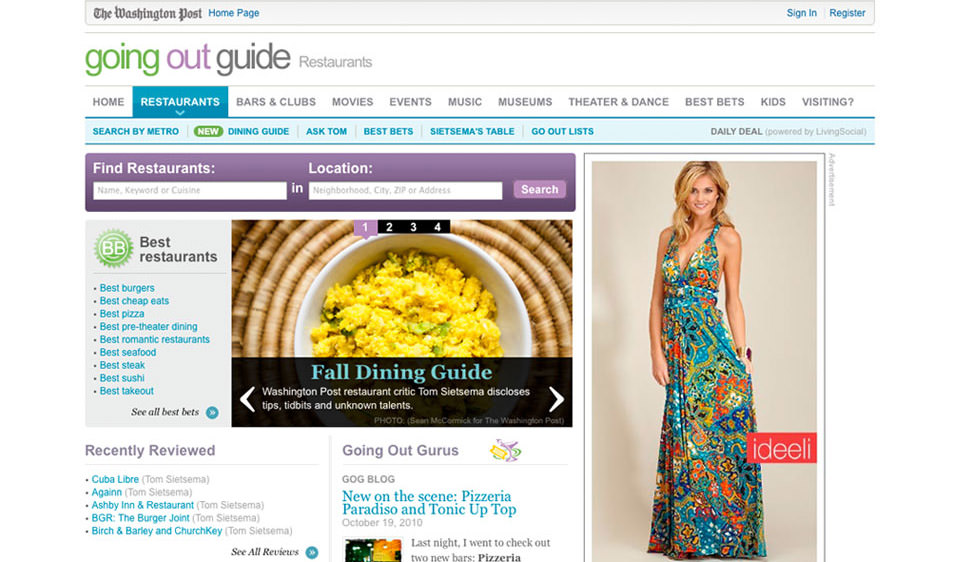The Washington Post.

The Washington Post, one of the nation’s most respected news organizations, was seeking a way to connect with younger audiences and take advantage of emerging media and technologies to increase outreach.
Because the Apple development environment had just been released, the task at hand was new to everyone involved: develop a native iPhone application to be launched simultaneously with the official Apple App Store launch. In addition to the mobile iOS application design and development, The Washington Post needed a partner to work with the existing Washington Post web team in a separate agile web development project consisting of three month-long sprints.
Strategy
We worked with The Washington Post development team to chart uncharted territory.
The Washington Post contacted nclud several months before the planned Apple App Store launch to begin brainstorming and development of a native iPhone application using the just-released iPhone Software Development Kit (SDK). Our user experience designers, strategists and software developers worked with The Washington Post to create their first iPhone application, the “City Guide.” The strategy was to create an application that leveraged The Washington Post’s competitive advantage over the many existing sites such as yelp that relied on user generated content by making use of the unique content that the paper has developed over time, in the form of easily accessible reviews from their expert food and entertainment writers. The application would allow users to browse and search thousands of DC metro area restaurants, bars and clubs by name, neighborhood, type of cuisine and price range. In addition, the application takes advantage of the geolocation capabilities of the device to show venues “near me” while providing interactive maps of matching locations.

Design
Design for native applications was a completely unexplored yet exciting new opportunity.
While many of the user experience and design paradigms of web and digital could be applied to native application development, the release of the new iOS platform and development kit provided areas for new exploration, as well as considerations unique to the touch screen interface. As such, we needed to tap into our existing understanding of design and UX best practices to see how they would apply to the new platform. In particular, we worked with the team at Apple to understand and accommodate for design patterns that addressed aspects of the interface as varied as tap-target sizes, scroll behavior, transition effects, and even battery life.
Our extensive experience designing for other platforms was invaluable, but with iOS being a brand new platform, we also relied on extensive user testing to ensure that the decisions we made were validated by real world usage prior to the launch of the application and the App Store itself. The branding and design for the companion desktop web application was then married up with the overall design themes for the iOS application, creating a cohesive experience across both platforms.




Development
Integrated teams and a proven methodology ensured our success.
Prior to this project, Native iOS development for the iPhone did not exist and we were fortunate enough to be given early access to the SDK by Apple in order to help The Washington Post achieve its goal of having an a native application in the App Store for launch day. We were ready for the challenge and were selected for the task based on our experience in working with native Mac development and other desktop development technologies such as Java Swing. Working closely with both Apple and The Washington Post and relying on our previous software development expertise, we were able to meet our goal of launching with the release of the App Store.
While the development of the City Guide native application was underway, The Washington Post team had another project with a tight internal deadline: The Going Out Guide. They required experienced staff who could assimilate quickly into their processes and provide ongoing development services alongside their own programmers, designers, QA, and business teams. We proposed an integrated team in which our developers would work onsite to more closely create and collaborate with the in-house Washington Post technical staff. This Agile approach included daily scrum meetings and interaction with a project lead, a team of twelve to fifteen programmers, a design team, a business team, and the QA team. The nclud team, made up of five full-time developers, was paired with a Washington Post developer for the duration of the project building out working interactive templates from wireframes. Working from the Washington Post offices, the team used CSS, XHTML, Java/J2EE, jQuery, Tomcat, Maven, Subversion, and Eclipse IDE to develop a stable and expandable platform for the newspaper to utilize and grow.
Results
The success of the app and companion site were off the charts.
The City Guide iPhone application launch coincided with Apple’s App Store launch as planned and was quickly one of the most adopted apps in the store — ranked on the first page of the most popular apps and hundreds of thousands of downloads in the first week. The Going Out Guide project was also a success and generated thousands of new pageviews per hour, with many repeat visitors relying on it as a valuable resource. The nclud team was able to efficiently fill a void in The Washington Post’s in-house capabilities and assisted tremendously in helping to meet very tight development deadlines.
